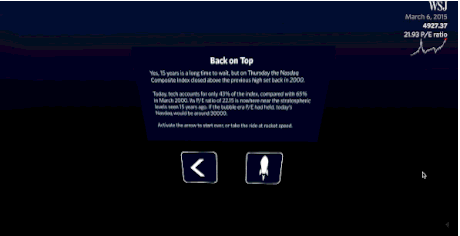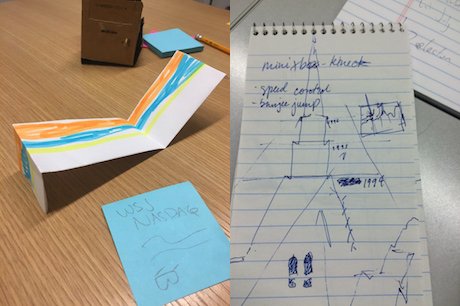
With daily ups and downs punctuating seismic peaks and troughs in the economy, stock markets are often compared to roller coasters for those that play – all exhilarating highs and sickening lows.
Now The Wall Street Journal has gone one step further, marking last week's record high on the Nasdaq exchange by building a virtual reality, three-dimensional line graph which viewers can 'ride' over the last 21 years.
"We wanted to take advantage of VR in order to viscerally emulate the experience of an investor," said Ana Becker, an interactive graphics editor and news apps developer at the Journal's New York office. "The 'roller coaster' view lets you understand how steep those climbs and drops were."
With a few clicks on a computer, the viewer is transported to 1994 and the start of the tech boom, climbing the graph through the 1990s before the Dot Com Bubble burst in March 2000.
When viewed on mobile and combined with Google Cardboard, a self-assembled cardboard headset which uses lenses and a device's sensors to create a virtual reality experience, the subsequent crash at the turn of the century is stomach-turning.

Screengrab from WSJ.com
"The first idea was that you would be able to freely walk along the Nasdaq," the Journal's global head of visuals, Jessica Yu, told Journalism.co.uk.
"It would be like this giant wall next to you and one of our reporters would pop out using a green screen. That person would be with you and you'd walk around this space."
The whole process over the course of recent weeks has been in trialling different features, with videos and statistics popping out of the great wall of Nasdaq as the user explored it, said Yu.
But the biggest sticking point proved to be the user interface as people "kept on running into walls", getting stuck, struggling to control the interface.
On Google Cardboard, an affordable but far from perfect headset, users aim their view at buttons to activate them, a feature only made possible through continued trial and error.
"There was a lot of pure and simple user interface stuff that we had to tweak," Yu said, "where you detect what the user is on and how best to explain what's going to happen to them.
"You see people who are clearly not reading the directions and it still has to work despite the fact that they blaze straight through the directions."

Original sketches of what would become the Nasdaq rollercoaster, courtesy of Jessica Yu
This is the Journal's first public experiment with VR but there have been notable examples in recent months as technological barriers to entry are lowered for users, and more newsrooms explore the possibilities.
In January, Vice experimented with a "virtual reality news broadcast" from the Millions March protest in New York, and yesterday the New York Times addedVR to its plans for growing a growing video output.
Chris Milk, who produced Vice's Millions March video with filmmaker Spike Jonze, also produced the UN's acclaimed Clouds of Sidra, which follows a young Syrian refugee through her makeshift camp.
"Actually to experience that in VR is really powerful," Yu said of Milk's Syrian film. "The shots themselves don't move but you can look around and it really gives you a sense of being there. Realistically most of our viewers will never be there."
The power of Milk's film is in immersing the viewer in the images, where words would never do justice to the scene. But VR can still play a role when pictures are not available.
Experienced journalist and VR pioneer Nonny de la Pena has recreated the 2012 shooting of unarmed black teenager Trayvon Martin as a VR experience, using audio from real 911 calls to soundtrack animated re-enactments of the night.There’s a whole new realm of possibilities to connect readers with data storiesRoger Kenny, The Wall Street Journal
"There are certain places where you'd definitely want to be there," Yu continued, "and rendering a Syrian refugee camp or Jordanian refugee camp would not be as effective so you would use video.
"Then there are certain things like the Nasdaq where... what would you shoot?"
Technologically, the main barrier remains in making the experience as frictionless as possible for the viewer. And as with every new medium technology adds to the journalist's storytelling toolbox, the key is in choosing the right story for the format.
"There are lot’s of possibilities," said Roger Kenny, the Journal's interactive designer who modelled much of the Nasdaq roller coaster. "Definitely more story-driven pieces, taking the viewer into a situation or showing someone else’s life close to their perspective. Also, location driven pieces are exciting.
"But illustrating some data for the reader in this way is in its infancy for our field. There’s a whole new realm of possibilities to connect readers with data stories.
"That’s what’s exciting, figuring all this stuff out."
Free daily newsletter
If you like our news and feature articles, you can sign up to receive our free daily (Mon-Fri) email newsletter (mobile friendly).
Related articles
- The Wall Street Journal launches archived content newsletter
- From problem solver to innovator: how bridge roles have evolved in newsrooms
- Robin Kwong, new formats editor of The Wall Street Journal, on evolving bridge roles
- 'Headlines in real time': The Wall Street Journal makes "live journalism" a hit during the pandemic
- Your comment section is only as good as your editorial strategy









